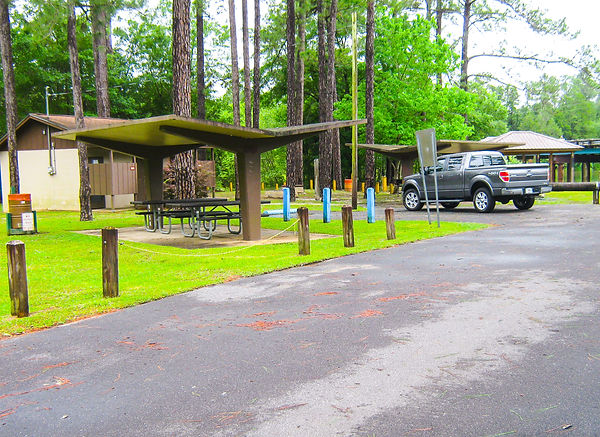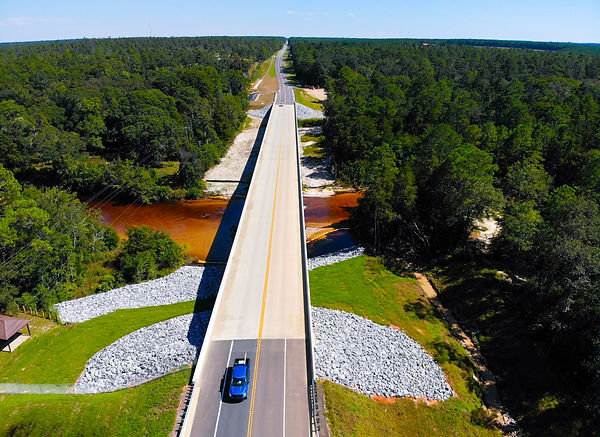SR 4 Over Blackwater
The State Road (S.R.) 4 bridge over the Blackwater River in Okaloosa County is located in a very environmentally sensitive area. The bridge needed to be replaced due to the structurally deficient rating of the bridge and its substandard deck geometry. The existing bridge was constructed in 1947, and, while it has served the state well, the combination of settlement, scour susceptibility, substandard shoulder widths, and traffic barriers resulted in the need for a bridge replacement with many environmental, hydraulic, and constructability challenges.
The water levels in the Blackwater River have extreme fluctuations, as much as 12 feet of rise in less than 12 hours. Not only is the bridge in the Blackwater River State Forest, but also crosses Blackwater River, an Outstanding Florida Water (OFW) and State Designated Paddling Trail. The bridge is also immediately adjacent to Cotton Bridge Park, a designated 4(f) facility, where access was maintained throughout construction.
Since the river is an OFW, the requirement for improved water quality of the runoff required the construction of five retention ponds within the available right of way. A temporary work trestle was mandatory in lieu of allowing the contractor to attempt construction from mats in the floodplain. The trestle improved contractor safety and mitigated the risk of having hazardous materials from the heavy construction equipment wash downstream causing environmental harm. The trestle also minimized the contractor’s footprint lessening environmental impacts at the site.

Temporary work trestle on the right side with
new bridge foundation construction in the middle
Complexity of Project: The project had many environmental, hydraulic and constructability challenges. The water levels in the river have extreme fluctuations, as much as 12 feet of rise in less than 12 hours. The riverbed is prone to scour and long-term meandering. The previous bridge often had significant buildup of logs and other debris which became jammed in the bridge’s substructure units. The site is an environmentally sensitive as it is in the Blackwater River State Forest, considered an OFW and is a State Designated Paddling Trail. The river experiences heavy recreational use and is immediately adjacent to the Cotton Bridge Park, a designated 4(f) facility, where access was maintained during all phases of construction.
Scheduling Challenges: Hurricane Sally delivered 20 feet of water rise to the river. The water level rose all the way to the low member of the existing bridge. The contactor had to reestablish all environmental controls and reconfirm the integrity of the work platform bridge. Battered Piles were eliminated on the project to minimize the risk of damaging the existing bridge and allowed the pile driving on the new bridge to proceed more expeditiously. Profile Thermoplastic material was in short supply and a 50-day time extension was granted.
Innovative Technical Concepts: The contract documents included mandatory use of a temporary work trestle in lieu of allowing the contractor to attempt construction from mats in the floodplain. The work trestle was necessary given the vast fluctuation of water levels in the river. Consideration included both contractor safety and mitigation of the risk of having contractor equipment wash downstream and cause environmental harm. The river had to remain open for recreational use (except while setting beams), so the construction equipment could not block the river and the trestle was set high enough to account for these factors. Wall piers were also designed and constructed to minimize the potential for debris entrapment.
Cost savings: Rather than use a temporary bridge resulting in throw-away construction and additional environmental impacts, the construction phasing was set up to maintain traffic on the existing bridge during construction. The new bridge and approaches were built on a slightly different alignment adjacent to the existing facility. This resulted in a savings of over $1 million and several months of construction time.

The river experiences heavy recreational use and is immediately adjacent to the Cotton Bridge Park
Public Involvement/Support: The project was not controversial, therefore no need for traditional public involvement meetings. However, communication with the public and stakeholders was performed during the design and construction phases by outreach with plenty of advance notice. During design, several comments were made by the public and other stakeholders, and the input was incorporated into the project as appropriate. Temporary closings of the Paddling Trail were allowed for safety reasons. The Contractor developed Informational Brochures that provided Paddling Trail users with pertinent information concerning the project. The Brochures were made available at boating outfitters in the area and posted at boat landings and public parks along the river.
Minimization of Negative Impacts: Staged construction allowed for significant reduction of environmental impacts. Traffic was maintained on the existing bridge while the new bridge was built and moved to the new bridge allowing removal of the old bridge. Using the existing bridge significantly reduced the footprint and environmental impacts of the project. Staged construction also allowed the public park and paddling trail to remain open to the greatest extent possible during construction. The design team included plan notes and coordination with FDEP’s Office of Greenways and Trails to ensure the public and users of the paddling trail were aware of the bridge construction. The bridge was designed with fewer pilings and longer spans resulting in less impacts to the river.
Partnering: FDOT and the design team fostered continuous partnership with the Contractor and utility owners. This fostered a great deal of mutual respect and helped the project go smoothly. FDOT routinely published lane closures and provided bi-monthly aerials to stakeholders via the Department website. The team executed a very high level of continuing communications even though there were no formal partnering sessions. The area stakeholders included the Forestry Service and the forestry industry, residents, commuters, utility companies, environmental groups, river users and more. FDOT, the Designer, and the Contractor worked closely and diligently with these stakeholders throughout the project to minimize project impacts.
Functionality of Project: Functionality of the project was enhanced by the construction of an improved entrance to Cotton Bridge Park and expansive green space under and around the bridge promoting wildlife connectivity. The design approach functioned very well during construction. There were several high-water events with very high flow rates and significant forest debris being washed downstream. The contractor informed FDOT and the Designer that if the temporary trestle was not mandatory, most contractors would have bid on the project based on working from mats in the river bottom (based on a low-bid approach). Had the trestles not been used, the storm events would have caused disastrous results to the project and surrounding environmentally sensitive areas.

Roadway Approach with Ponds
Environmental Impacts/Benefits: Because the project did not increase capacity, it was not required to treat runoff from the roadway. However, considering the river is an Outstanding Florida Water, five retention ponds were constructed within the available right of way to improve the water quality being discharged from the site to the Blackwater River. This was looked upon very favorably by the permitting agencies and the public. The design concepts that were incorporated were a result of forward thinking and addressing the environmental concerns early in the design process. As a result, as the project went to permitting, the process was smooth and did not result in major design changes since the design team proactively addressed issues beforehand.
Sustainability: Because the new bridge was built higher and longer than the original bridge, the bridge is less likely to incur impacts from tropical events or hurricanes and other potential disasters. The bridge was designed to provide a minimum of a 75-year design life. This project will serve the local communities and commuters well into the future. With longer bridge spans and wall piers in the main river channel, FDOT’s maintenance crews will not have to clear the accumulated debris from the substructure as often as was required in the past. Concrete beams were used in lieu of steel to minimize required maintenance. The contractor hauled away the debris from demolition of the old bridge to a local recycler.
Cost Overruns and Time Extensions: Cost overruns and time extensions were minimal. The original contract amount was $10,228,410 with a final amount of $10,503,985 resulting in a cost increase of only 2.7%. The contract time was increased from 925 days to 1,350 days due partly to 130 weather days and 179 days of approved time extensions.
Technical/Engineering Challenges Overcome: The bridge foundation design accommodated the artesian conditions at the site. The design progressed with a focus on avoiding a breach of the aquitard (also known as a confining bed) and resulting environmental impacts. Based on the history of the main channel migrating over the past 70+ years, the design accounted for the potential for future channel migration without compromising the integrity of the bridge or surrounding areas. Design considered the Blackwater River’s history of rapid changes to water surface elevations. The work trestle included in the design took this into account for contractor safety, mitigate the risk of having contractor equipment wash downstream, and minimize site environmental impacts.
Safety Improvements: The narrow width of the original bridge was problematic for vehicles transporting wide loads as it did not have shoulders. The new bridge provides 10-foot shoulders. Safety was improved for the river users by making spans longer and wall pier
design and construction to minimize the accumulation of logs up against the substructure. Because the current can be swift, river users in canoes and kayaks could get driven into the log jam and overturn. The sight distance for vehicles exiting the Cotton Bridge Park was improved by relocating the driveway farther from the bridge. Also, the grade of the driveway from the park onto SR 4 was constructed at a flatter grade in consideration of the people with trailers who use the boat ramp in the park.




